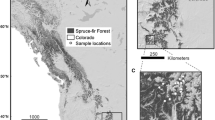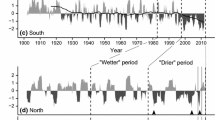Summary
Long-term growth patterns of red spruce (Picea rubens Sarg.) were analyzed from increment cores collected from over 1000 trees at 48 sites in the eastern United States. Principal objectives were the evaluation of the distribution, timing, and uniqueness of observed patterns of decreasing radial growth during the past 25 years and the examination of stand competition and climate as factors contributing to observed changes.
Our analyses focused on historical records of spruce mortality and approximately 200 years of radial growth data to search for historical precedents for current trends. In this work we have used time series analysis to detect the temporal frequency of significant negative or positive shifts in radial growth rates, an analysis of relationships between a stand competition index and observed changes in growth and mortality, and modeling of past growth-climate relationships to determine whether recent growth changes could be predicted based on climate.
Collectively, these analyses indicate that the observed growth decreases of surviving red spruce trees at northeastern sites with high mortality have been anomalous during the past 20 to 25 years with respect to both historical annual growth patterns and past relationships to climate or stand development at these sites. In general, reductions in radial increment that have also been noted at southern high elevation sites but not at low elevations occurred 5 to 10 years later than at northern sites and represent less substantive departures from growth trends predicted by linear climate models.
These results suggest that regional and not local stresses have triggered the observed decline in radial growth of red spruce at these sites. While climatic change may have contributed to observed changes, the degree of radial growth suppression observed is greater than would be expected based on past growth-climate relationships. This unique relationship of growth to climate suggests the influences of either recent, unique combinations of climatic stresses or the possibly interactive intervention of other regional-scale stresses, such as atmospheric pollution.
Similar content being viewed by others
References
Adams HS, Stevenson SL, Blasing TJ, Duvick DN (1985) Growth-trend declines of spruce and fire in mid-Appalachian subalpine forest. Environ Exp Bot 25:315–325
Bell W (1983) A computer program (TEST) for detecting outliers in time series. In: Proc, Business and Economics Section 1983 American Statistical Association Annual Meeting, August 1983, pp 624–639
Blasing TJ, Duvick DN (1984) Reconstruction of precipitation history in North American corn belt using tree rings. Nature 307:143–145
Blum BM, Bemie JW, Muski E (1983) Eastern spruce-fir. In: Burns RM (ed) Silvicultural systems for the major timber types of the US Agr Hardbook 445. Washington, DC, pp 128–130
Box GEP, Tiao GC (1975) Intervention analysis with application to economic and environmental problems. J Am Stat Assoc 70:70
Box GP, Jenkins GM (1970) Time series analysis forecasting and control, Holdon Day, San Francisco, CA
Bruck RI, Robarge WP (1984) Observations of boreal montane forest decline in the southern Appalachian Mountains: Soil and vegetation studies. In: Aquatic effects task group (E) and terrestrial effects tast group (F) Research summaries. North Carolina State Acid Deposition Program, Raleigh, NC, p 425
Cargey AC, Miller EA, Geballe GT, Wargo PM, Smith WH, Siccama TG (1984) Armillaria mellea and decline of red spruce. Plant Dis Rep 68:794–795
Chang IH (1982) Outliers in time series. PhD Dissertation Department of Statistics, University of Wisconsin-Madison
Conkey LE (1979) Dendroclimatology in the Northeastern United States. MS Thesis, Department of Geosciences, University of Arizona, Tucson, 78 pp
Conkey LE (1982) Eastern U.S. Tree-ring widths and densities as indicators of past climate. PhD Dissertation, Department of Geosciences, University of Arizona, Tucson, 204 pp
Cook ER (1985) A time series analysis approach to tree ring standardization. PhD Dissertation, Department of Geosciences. University of Arizona, Tucson
Cook ER (1987) The use and limitations of dendroclimatology in studying effects of air pollution on forests. Proceedings of NATO Advanced Research Workshop: Effects of Acid Deposition on Forests, Wetlands, and Agricultural Ecosystems May 12–17, Toronto, Canada (in press)
Cook ER, Jacoby GC (1977) Tree-ring-drought relationships in the Hudson Valley, New York. Science 198:399
Diaz HF, Quayle RG (1978) the 1976–77 winter in the contiguous United States in comparison with past records. Mon Weather Rev 108:1393–1421
Foster JR, Reiners WA (1983) Vegetation patterns in a virgin subalpine forest at Crawford Notch, White Mountains, New Hampshire. Bull Torrey Bot Club 110:141–153
Friedland AJ, Gregory RA, Karenlampi L, Johnson AH (1985) Winter damage to foliage as a factor in red spruce declinc. Can J For Res 14:963–965
Fritts HC, Gordon GA, Lofgren GR (1979) Variations in climate since 1602 as reconstructed from tree rings. Q Res 12:18–46
Fritts HC, Blasing TJ, Hayden BP, Kutzbach JE (1971) Multivariate techniques for specifying tree growth and climate relationships and for reconstructing anomalies in paleoclimate. J Appl Meteorol 10:845–846
Hamburg SP, Coybill CV (1986) Long-term population decline of red spruce (Picea rubens. Sarg.) in tree hardwood forests of central New Hampshire. Unpublished manuscript, Stanford University
Hart AC (1959) Silvicultural characteristics of red spruce (Picea rubens). Station Paper 124, Upper Danby, Pennsylvania. USDA Forest Service, Northeastern Forest Exp Sta, Broomall, Pennsylvania, 22 pp
Hadfield JS (1968) Evaluation of diseases of red spruce on the Chamberlin Hill Sale, Rochester Ranger District, Green Mountain National Forest. File report A-68-8 5230. USDA-Forest Service Northeastern Area, State and Private Forestry Amherst FPC Field Office, Amherst, Massachusetts. 7 pp
Holmes RL (1985) Computer assisted quality control in tree ring dating and measurement. A users manual for program COFECHA, Laboratory of Tree Ring Research, University of Arizona. November 1985
Hopkins AD (1899) Report on investigation to determine the cause of unhealthy conditions of spruce and pine crom 1880–1893. W Va Agric Exp Sta, Bull 56:197–254
Hopkins AD (1901) Insect enemies of the spruce in the northeast. USDA Div of Ento Bull No. 28-new series
Hornbeck JW, Smith RB (1985) Documentation of red spruce growth decline. Can J For Res 15:1191–1201
Houston DR (1981) Stress triggered tree diseases, the diebacks and declines. Forest service report NE-INF-41-81. US Department of Agriculture, Washington, DC
Johnson AH, McLaughlin SB (1986) Deterioration of red spruce in the northeastern Appalachian Mountains. Report of the Committee on monitoring and trends in acid deposition. National Academy Press, Washington, DC (in press)
Johnson AH, McLaughlin SB (1985) The nature and timing of the deterioration of red spruce populations in Appalachian forests. In: Monitoring and assessing trends in acidic deposition. National Academy of Sciences, Washington, DC (in press)
Johnson AH, Siccama TJ (1983) Acid deposition and forest decline. Environ Sci Technol 17:294
Karl TR, Metcalf LA, Nicodemus ML, Quayle RG (1983) Statewide average climate history (by state), Historical climatology series 6-1. National Climatic Data Center, Asheville, NC
Kelso EG (1965) Memorandum 5220, 2480 of July 23, 1965. US Forest Service Northern FPC Zone 6 Main Street Amherst, Massachusetts
Kulow DL (1965) Elementary point-sampling. West Virginia Agricultural Experiment Station, Morgantown, West Virginia, 31 pp
Manion PD (1981) Tree disease concepts. Prentice Hall, Englewood Cliffs, NJ
McIntosh RP, Hurley RT (1964) The spruce fir forests of the Catskill Mountains. Ecology 45:324
McLaughlin SB (1985) Effects of air pollution on forests: A critical review. J Air Pollut Control Assoc 35:511
McLaughlin SB, Blasing TJ, Mann LK, Duvick DN (1983) Effect of acid rain and gaseous pollutants on forest productivity: A regional approach. J Air Pollut control Assoc 33(11):1042
McLaughlin et al. (1987) FORAST Data Base Documentation. A summary of data collected in a collaborative project. EPA (in press)
Meyer WH (1929) Yields of second growth spruce and fir in the northeast. Technical Bulletin No. 142, US Department of Agriculture, 53 pp
Mosteller F, Tukey JW (1977) Data analysis and regression: a second course in statistics. Addison Wesley, Reading, MS
Mueller-Dumbois D (1985) Canopy dieback and successional processes in Pacific forests. Pac Sci 37:317–325
New York State (1885) First report of the New York state forest commission. Albany, NY
New York State (1891) Second annual report of the New York state entomologist, Albany, NY
New York State (1896) Seventh report of the forest commission, Albany, NY
Oosting HJ, Billings WD (1951) A comparison of virgin spruce-fir forest in the northern and southern Appalachian system. Ecology 32:84–103
Palmer WC (1965) Meteorological drought. Weather Bureau Research Paper No. 45. U.S. Department of Commerce, Washington, DC 58 pp
Pielke RA (1979) The distribution of species in West Central Virginia before lumbering. Report No. UVA-ENVSCI-NESCO-1971-1, University of Virginia, Charlottesville, VY
Reilly DB (1984) Automatic intervention detection system. Presented at 1984 American Statistical Association Meeting, Business and Economics Statistics Section
Reineke LH (1933) Perfecting a stand-density index for even-aged forests. J Agric Res 46:627–638
Scott JT, Siccama TG, Johnson AH, Breisch AR (1984) Decline of red spruce in the Adirondacks, New York. Bull Torrey Club 111:438–444
Siccama TG (1971) Presettlement and present forest vegetation in northern Vermont with special reference to Chittenden County. Am Midl Nat 85:153–172
Siccama TG (1974) Vegetation, soil, and climate on the Green Mountains of Vermont. Ecol Monogr 44:325–349
Siccama TG, Bliss M, Vogelmann HW (1982) Decline of red spruce in the Green Mountains of Vermont. Bull Torrey Bot Club 109:163
Stark DA, Unpublished notes on red spruce browning in Maine. State of Maine, Department of Conservation. Entomology Laboratory, 50 Hospital Street, Augusta, ME 04330
State of New York Conservation Commission 25–29th Annual Reports, 1935–1939
Stevenson SL, Adams HS (1984) The spruce-fir forest on the summit of Mount Rogers in southwestern Virginia. Bull Torrey Bot Club 111:69–75
Tegethoff AC (1964) Memorandum 522, Sept. 25 1964. White Mt Nat Forest. High elevation spruce mortality. US Forest Service Northern FPC Zone, 6 Main St., Amherst, MS, 2 pp
U.S. Department of Agriculture (1971) The Red spruce: its growth and management. Technical Bulletin No. 544. US Department of Agriculture, Washington, DC, 99 pp
Weiss MJ, McGeary LR, Millers I, O'Brien JT, Miller-Weeks M (1985) Cooperative survey of red spruce and balsam fir decline and mortality in New Hampshire, New York, and Vermont — 1984. Interim Report. USDA Forest Service, Forest Pest Management, P.O. Box 640, Durham, NY, 130 pp
Wheeler GS (1965) Memorandum 2400, 5100 July 1, 1965. White Mountain National Forest, Laconia, NH
Author information
Authors and Affiliations
Additional information
Although the research described in this article has been funded wholly or in part by the United States Environmental Protection Agency (EPA) through Interagency Agreement Number DW 89931334-01-0 with the U.S. Department of Energy, it has not been subjected to EPA review and therefore does not necessarily reflect the views of EPA, and no official endorsement should be inferred
Rights and permissions
About this article
Cite this article
McLaughlin, S.B., Downing, D.J., Blasing, T.J. et al. An analysis of climate and competition as contributors to decline of red spruce in high elevation Appalachian forests of the Eastern United states. Oecologia 72, 487–501 (1987). https://doi.org/10.1007/BF00378973
Received:
Issue Date:
DOI: https://doi.org/10.1007/BF00378973




